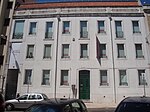Rato (Lisbon Metro)
European rapid transit stubsLisbon Metro stationsLisbon geography stubsRailway stations opened in 1997

Rato station is the southern terminus of the Yellow Line of the Lisbon Metro.
Excerpt from the Wikipedia article Rato (Lisbon Metro) (License: CC BY-SA 3.0, Authors, Images).Rato (Lisbon Metro)
Rua do Sol ao Rato, Lisbon Santa Isabel (Campo de Ourique)
Geographical coordinates (GPS) Address Website Nearby Places Show on map
Geographical coordinates (GPS)
| Latitude | Longitude |
|---|---|
| N 38.72 ° | E -9.1558333333333 ° |
Address
Convento de Nossa Senhora dos Remédios (Mosteiro das Trinitárias do Rato;Convento das Trinas do Rato;Nossa Senhora dos Remédios das Religiosas da Santíssima Trindade;Mosteiro das Trinas do Rato)
Rua do Sol ao Rato
1250-360 Lisbon, Santa Isabel (Campo de Ourique)
Portugal
Open on Google Maps








